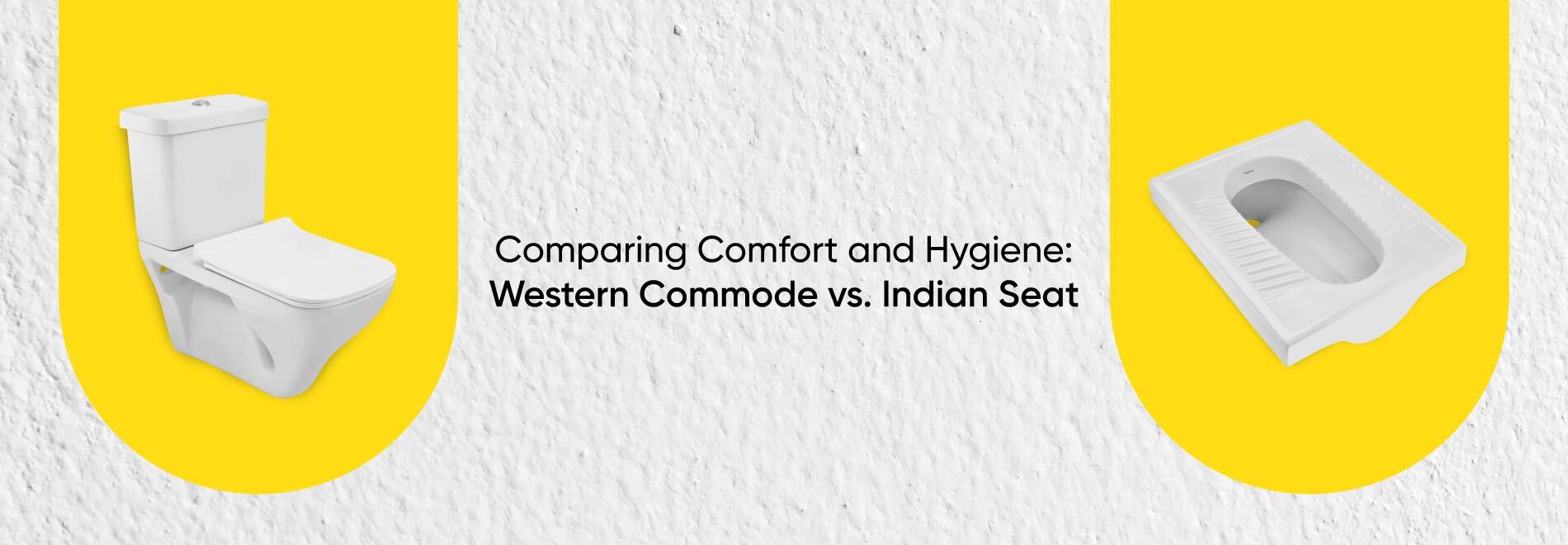Remember the iconic Bollywood movie Piku? Amitabh Bachchan's character, Bhaskor Banerjee, struggles with chronic constipation, turning his life into a series of comical yet relatable events centered around his digestive woes. Despite trying various remedies and modern facilities, he finds no relief. However, in a pivotal moment, on Irrfan Khan's suggestion, he returns to the traditional Indian commode and finally finds the relief he had been seeking. This humorous yet insightful scene highlights the ongoing debate between the use of Western commodes and Indian seats.
When it comes to personal hygiene and comfort, the choice of toilet can significantly impact our daily lives. In many parts of the world, Western commodes and Indian seats represent two distinct approaches to sanitation, each with its own set of advantages and considerations.
Western Commodes VS Indian Seat
| Feature | Western Commode | Indian Seat |
|---|---|---|
| Comfort | Comfortable seating position | Requires squatting |
| Hygiene | Requires regular cleaning of the seat | Minimizes direct contact |
| Health Benefits | Suitable for mobility issues | Promotes better bowel movements |
| Water Usage | Higher water consumption | Lower water consumption |
| Accessibility | Designed with accessibility features | Challenging for mobility issues |
| Maintenance | More components requires regular maintenance | Simpler design, easier to maintain |
| Cost | Generally, a higher initial cost | Lower initial cost |
| Durability/Longevity | Durable but requires maintenance | Highly durable, fewer parts to break down |
Historical Background
Origins and Prevalence of Western Commodes
Western commodes, also known as Western toilets or sit-down toilets, gained popularity during the Victorian era in the 19th century. Their design features a raised, chair-like seat and a flushing mechanism. Today, they are widespread in urban areas worldwide, including India.
Origins and Prevalence of Indian Seats
Indian seats, commonly referred to as squat toilets, have been in use for thousands of years. This traditional toilet design is prevalent in many parts of Asia and consists of a hole in the ground with footrests on either side. Users squat over the hole to relieve themselves.
Comfort Comparison
Comfort of Western Commodes
Western commodes are like sitting on your favorite chair. They provide a comfortable seating position, especially beneficial for the elderly, individuals with mobility issues, and those who prefer sitting over squatting.
Comfort of Indian Seats
Indian seats may seem less comfortable to some, but they offer unique advantages. Squatting aligns the body for easier and more complete bowel movements, though it can be challenging for those not accustomed to it.
Hygiene Comparison
Hygiene Benefits of Western Commodes
One concern with Western commodes is the direct contact with the toilet seat. However, regular cleaning and modern features like self-cleaning seats and touchless flushing can ensure a hygienic experience.
Hygiene Benefits of Indian Seats
Indian seats minimize direct contact with the toilet surface, reducing germ transmission. This makes them particularly hygienic in public or shared restrooms.
Health Implications
Western toilets offer a comfortable and stable seating position, which is beneficial for those with mobility issues. However, some studies suggest that sitting may not be as effective for bowel evacuation as squatting.
Squatting, as required by Indian seats, aligns the body to promote easier bowel movements and may reduce the risk of digestive issues like constipation and haemorrhoids.
Environmental Impact
Western toilets typically use more water per flush. However, modern Western commodes with water-saving features like dual-flush systems can help reduce water usage.
Indian seats generally require less water for operation, making them more environmentally friendly, particularly in areas with limited water resources.
Accessibility and Maintenance
Western commodes are designed with accessibility in mind, featuring support rails and raised seats, making them suitable for individuals with mobility issues.
Indian seats can be challenging for people with mobility issues, as they require squatting. This position can be difficult for the elderly and those with joint problems.
Maintenance Requirements for Both Types
Western commodes have more components, which can require regular maintenance. In contrast, Indian seats are simpler and easier to maintain.
Cultural Significance
Cultural Influences on the Preference for Each Type
The choice between Western commodes and Indian seats is often influenced by cultural preferences. In many Eastern cultures, squatting is considered more natural, while Western toilets are associated with modernity and comfort.
Also, one of the important things while traveling or relocating is that one can adapt to different toilet types. Understanding the pros and cons of each can help ease this transition.
Conclusion
Both Western commodes and Indian seats have unique benefits and drawbacks. Western toilets offer comfort and accessibility, while Indian toilets promote better bowel health and hygiene. The best choice depends on individual needs and cultural practices. For affordable and reliable sanitary solutions, Essco by Jaquar Group offers a wide range of sanitaryware products designed to meet various preferences and requirements.
FAQs
Q. Which toilet seat is good for health?
A. Both Western commodes and Indian seats have health benefits. Indian toilets may promote better bowel health due to the squatting position, while Western commodes are more comfortable for people with mobility issues.
Q. Which is better for people with mobility issues?
A. Western toilets are better for people with mobility issues as they provide a comfortable seating position and often include accessibility features like support rails.
Q. Which type of seat is easier to clean?
A. Indian seats are generally easier to clean due to their simpler design, which has fewer parts that can get dirty or break down.
Q. Which is more hygienic: a Western commode or an Indian seat?
A. Indian seats can be more hygienic because they minimize direct contact with the toilet surface, reducing the risk of germ transmission. However, regular cleaning can make Western toilets equally hygienic.


